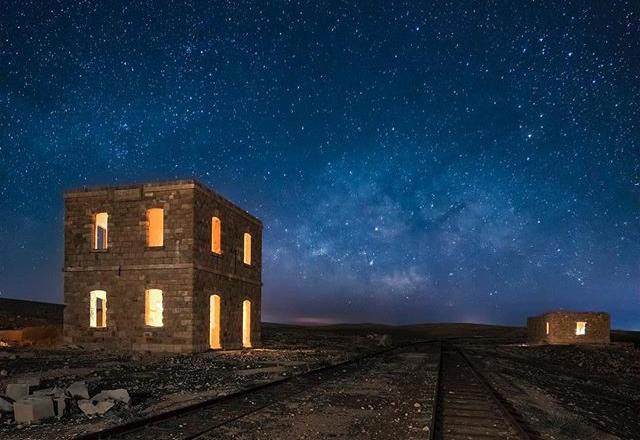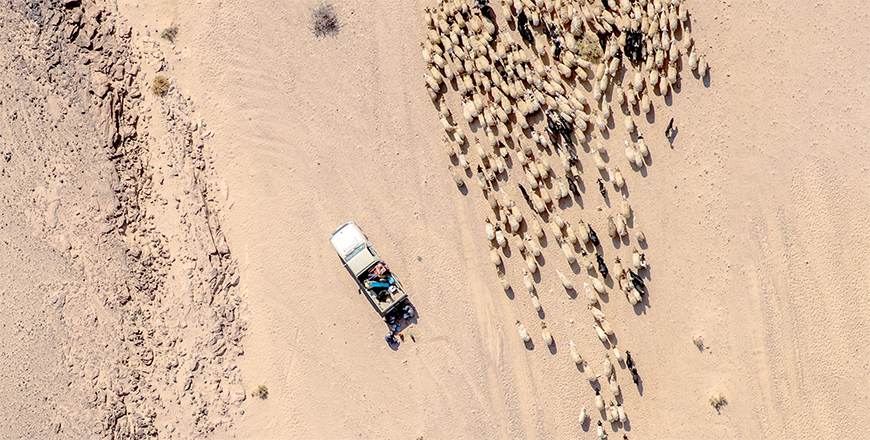You are here
Jordanian embarks on quest to capture Kingdom’s ‘forgotten’ sites
By Saeb Rawashdeh - Jan 16,2019 - Last updated at Jan 16,2019

Ajloun Castle, located 60km northwest of Amman, is seen at night, in this undated photo. Photographer Bashar Tabbah travelled to sites, both popular and not, in his journey to photograph Jordan’s heritage (Photo courtesy of Bashar Tabbah)
AMMAN — With each trip to one of Jordan’s archaeological sites, a local photographer’s fascination and passion to document their beauty grew.
“Having easy access to such a vast amount of beautiful sites captured my imagination, and I wanted to learn about those who left these places behind, and more importantly, what else was out there,” said Bashar Tabbah, who recently published a book “Jordan: Sights Unseen and Stories Untold”.
However, his ambition did not stop with Jordan, and he instead travelled and documented sites within the region and beyond, including Uzbekistan, Palestine, Australia and India. “So far I have visited over 200 historical locations worldwide and 250 in Jordan,” Tabbah noted.
The Jordan project was born out of Tabbah’s desire to explore and photograph all the sites listed in the “Blue Guide to Jordan” by Sue Rollins and Jane Streetly, but it soon grew in scope and reach.
“Soon after we began exploring, the list of sites that piqued our interest started multiplying. Not long after, a network of help began to emerge. I would reach out to people for assistance or guidance and they would deliver,” the photographer remembered.
The project was split into two parts — exploration and photography, and research and writing. During the photography phase, Tabbah received help from David Kennedy, a British-Australian archaeologist with extensive knowledge about Jordan.
Kennedy offered Tabbah suggestions about sites he had missed and provided valuable information on the locations of some of the more remote sites.
As for the research and writing, Tabbah said help came from numerous people, whose roles ran the gamut — editing, translating, confirming facts, disputing common misconceptions and providing tips and resources.
The book highlighted sites that are not very popular or even well-known among tourists. Tabbah said: “I think there are multiple factors behind the reasons why tourists tend to visit two to three of our main sites and leave the rest.”
In his opinion, because Jordan is a geographically small country, people mistakenly assume there is not a lot to explore and that, ultimately, not much time should be spent here.
The second reason is the popularity and religious significance of sites in neighbouring countries.
The third is the lack of development at historic sites in Jordan: “After Umm Al Rassas was developed and promoted as a significant site, it got more traffic. The same needs to happen with other sites around the Kingdom,” he stressed.
Tabbah said that the number sites in the Kingdom that he loves is very long, but a few worth mentioning include Qasr Bashir — a Roman fort standing on its own in the middle of the desert. “It’s spectacular, and gives a real impression of what the Roman eastern frontier would have looked like in its heyday.”
Qweilbeh/Abila — a Roman Decapolis with “tombs and buried monuments, hidden amongst rolling hills and olive groves that evokes an atmosphere of a city forgotten to the past”, he said.
Mount Aaron — a religious tomb of Prophet Aaron, located on a remote mountain in Petra. The shrine is one of the last remaining Mamluk structures in the Kingdom.
Lahun — an Iron Age citadel overlooking Wadi Mujib, “while nothing is left of the ruins, the views overlooking the wadi are breathtaking”.
"Historic sites need to be developed and protected, so that increased traffic won’t destroy what remains. Education, both locally and internationally, is also needed,” Tabbah pointed out.
So what is next for Tabbah?
“Concerning the next project, I have a number of concepts that I’m developing, some Jordanian focused... I also have plans to collaborate with scholars to create a project highlighting the incredible pre-Islamic inscriptions located throughout Jordan,” Tabbah concluded.
As for his plans for the near future, they include an international tour to promote Jordanian cultural heritage through his book, as well as a number of events, including a photography exhibition in Jordan.
Related Articles
AMMAN — Jordanian photographer Bashar Tabbah’s exhibition titled, “Stars and stone” and emphasising night shots of Jordan’s historical sites
AMMAN — After publishing “A Map and a Lens: Jordan Sights Unseen and Stories Untold”, “Unique and Outstanding” and “The Noble Sanctuary”, th
AMMAN — Jordanian photographer Bashar Tabbah captivated the audience at the British Council for Research in the Levant (CBRL), with a “photo














